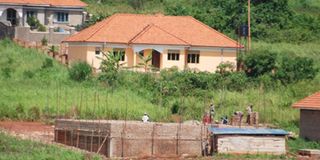Build a strong foundation in a water logged area

Building in a watterlogged area is not always wise, but if one must do it, it is important construct a very strong foundation. Photo by Ismail Kezaala
Setting up a solid house foundation in a water logged area is one of the hardest tasks because its tricky, consumes a lot of time, energy and money. It’s a step that should be given more attention to avoid collapsing and other accidents on a site during and after construction as Atuhaire Amon, a builder explains
Building a strong foundation in a water logged area mainly constitutes of two important stages;
Excavation/underground digging
Excavation in a water logged area should be at a depth of between three to five feet deep in the ground. This is done because when you set up a house without first considering what effect water will have on it, chances are that you might end up incurring double stretching expenses. After excavating about five feet deep, its always advisable to first lay a layer of hard core stones that are relatively bigger in size and not soil as most people do, reason being water from underground easily penetrates through soil. If available, the use of a hand or mechanical operated compressor is advisable to compact and compress the stones together.
After laying hard core stones, they should be followed by relatively smaller stones (gravel) and then a heavy heap of soil that should also be compressed to fill the gaps left unfilled by stones. This is done to ensure that there are no spaces left to prevent easy penetration and spillage of water.
It is then advisable to leave the newly laid foundation for some time of about three to six months for an area that is seasonally water logged and six to 12 months for an area that is averagely water logged before the final work plan of building is set up. This is because the compressed stones and the disintegrated soil must be given room to fully attach itself together to attain a firm and strong foundation.
The area where the new foundation has been set up should be cordoned off in a fence and proper drainage channels put up around it to prevent occurrences of massive erosion of the soil that has been compacted.
Constructing a raised platform
Atuhaire says that constructing a raised platform is another key factor as far as building a house in a water-logged area is concerned. After building the first phase of the underground foundation and giving it time to become firm, a raised platform is then built but its height from the initial ground depends on the level of water loggedness of the area. Usually for areas where you dig deep and you find that there is water down, the raised platform has to at least stand high at a height of about two to three(2-3ft) feet from the initial ground.
At this process or stage, a lot of concentrated cement and 9mm by 9mm cement bricks should be used because water cannot easily penetrate them. Alternatively, hard core stones aligned and used in proper order as bricks can be used in place of cement bricks. This is because when the small bricks are used, they wear out with time as a result of excessive coldness resulting from water which may cause the house to collapse. After raising the new platform, it has to be filled and leveled with hard core stones, followed by gravel and then sand and still compressed to make it firm.
Then when it comes to laying of the final concrete layer, containing of gravel, sand, cement and nets, the thickness of the concrete layer should be at least five inches accompanied with concentrated cement.




